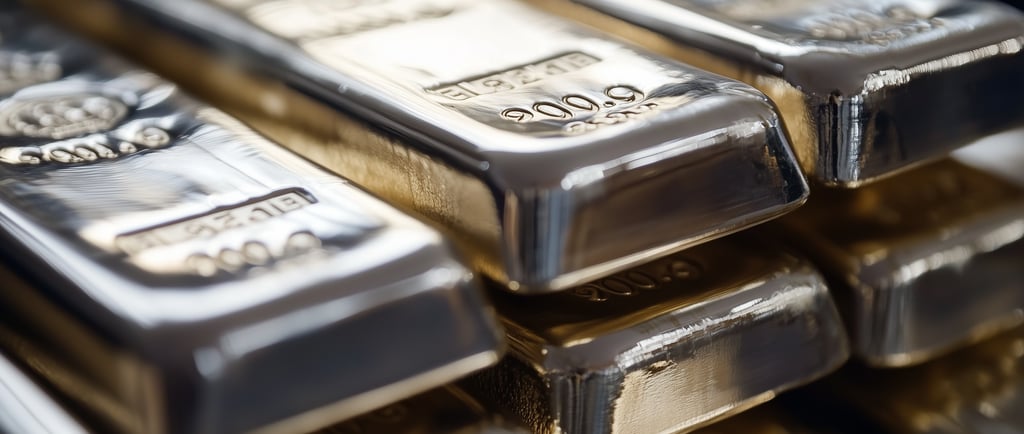

Disclosure: Clicking on links may earn me commission from joining Augusta Precious Metals, at no additional cost to you. Thanks for reading!
Learn the process of a silver IRA rollover, outlining how to move retirement funds into physical silver assets.
How to Perform a Silver IRA Rollover
Disclaimer: This website and its content are for informational purposes only and is not financial advice.
Open a self-directed IRA, transfer funds from your existing IRA, and then purchase silver through your custodian for IRS-approved storage. Consult a financial advisor for guidance.
What is a Silver IRA Rollover?
A rollover, in the context of retirement accounts, is the process of moving funds from one retirement account to another without incurring taxes or penalties. When you perform a silver IRA rollover, you're essentially moving funds from an existing retirement account, such as a 401(k), traditional IRA, or Roth IRA, into a new self-directed IRA that allows you to hold physical silver. This process needs to be handled carefully to maintain the tax-advantaged status of your retirement funds.
The distinction between a rollover and a transfer is an important one. While both involve moving retirement funds, a direct transfer (or trustee-to-trustee transfer) is a direct movement of funds from one IRA custodian to another, usually without the account holder ever touching the money.
A rollover, particularly an indirect rollover, involves the account holder receiving a check and being responsible for depositing it into the new account within a strict 60-day window. For most individuals, especially those new to this process, a direct rollover is the preferred method for a seamless silver IRA rollover as it minimizes the risk of tax penalties.
Understanding the difference is crucial for a successful silver IRA rollover. The ultimate goal is to move your savings into a precious metals IRA efficiently and without triggering a taxable event. The funds you are rolling over can come from various qualified retirement plans, including:
An old 401(k) from a previous employer
Another traditional IRA
A Roth IRA
Regardless of the source, the process is similar, but the rules and documentation will vary slightly depending on the specific account. A well-executed silver IRA rollover can provide peace of mind by protecting a portion of your retirement savings with a tangible asset.
Step 1: Finding a Reputable Custodian
The first step in initiating a silver IRA rollover is to find a reputable custodian that specializes in self-directed IRAs holding precious metals. Not all IRA custodians offer this option, so it’s crucial to do your research. Look for custodians with a strong track record, transparent fee structures, and excellent customer service. These custodians will guide you through the necessary paperwork and ensure your silver IRA rollover adheres to IRS regulations.
Your choice of custodian is one of the most critical decisions you will make during this process. The custodian is the financial institution that holds your IRA assets on your behalf and handles all administrative duties. They are legally required to manage the account according to IRS rules. An experienced custodian for a silver IRA rollover will be well-versed in the unique requirements of precious metals IRAs, including the specific purity standards for silver and the rules for approved depositories.
When researching custodians, consider factors like:
Fee Structure: Look for transparent fees, including annual fees, storage fees, and transaction fees.
Customer Reviews: Check for a history of positive customer feedback and service.
Support and Expertise: Ensure they have a knowledgeable staff that can guide you through the specific requirements of a silver IRA rollover.
Relationships with Dealers: Some custodians have preferred relationships with precious metals dealers, which can simplify the buying process.
A professional and knowledgeable custodian can make the silver IRA rollover process straightforward and stress-free. Conversely, a poor choice can lead to delays, unexpected fees, or even non-compliance with IRS rules, which could result in taxes and penalties.
Step 2: Opening a Self-Directed IRA Account
Once you’ve selected a custodian, you’ll need to open a self-directed IRA account. The custodian will provide you with the required forms to complete. This process typically involves providing your personal information, details about your existing retirement account, and specifying the type of silver you wish to hold. It’s important to understand the IRS guidelines on the purity and form of silver that can be held in an IRA. Typically, this includes silver bullion bars and coins that meet specific fineness requirements.
The IRS has strict rules about what precious metals can be held in an IRA. For silver, the required fineness is .999 fine (99.9% pure) or higher. Common examples of eligible silver products include:
American Silver Eagles
Canadian Silver Maple Leafs
Australian Silver Kangaroos
Austrian Silver Philharmonics
Certain government-minted coins and bullion bars from approved refiners
Non-eligible items include collectible coins, such as pre-1965 U.S. silver coins, and certain foreign coins, as they are considered collectibles and not investment-grade bullion by the IRS. Your custodian will be able to confirm which products are eligible for your silver IRA rollover.
The account opening forms will also ask you to designate a beneficiary for your new IRA. This is an important step to ensure your assets are passed on to your chosen heirs in the event of your passing. Taking the time to fill out the forms accurately and completely will prevent delays in your silver IRA rollover process. If you have any questions, don’t hesitate to contact your custodian’s customer service for assistance.
Step 3: Transferring Funds Through a Rollover
Next comes the actual rollover of funds. There are two main types of rollovers: direct and indirect. A direct rollover involves your existing retirement account administrator directly transferring the funds to your new silver IRA custodian. This is generally the preferred method as it avoids any potential tax implications or penalties.
An indirect rollover, on the other hand, involves you receiving a check from your existing retirement account. You then have 60 days to deposit these funds into your new silver IRA. However, indirect rollovers can be more complex and carry the risk of tax implications if the funds are not deposited within the specified timeframe. For a seamless silver IRA rollover, a direct transfer is usually recommended.
A direct rollover is the safest and most efficient way to complete a silver IRA rollover. The funds move directly from your current account to your new one without you ever taking possession of them.
This eliminates the risk of missing the 60-day deadline and the associated penalties, which can include a 10% early withdrawal penalty (if you are under 59½) and income taxes on the entire amount. To initiate a direct rollover, you will typically fill out a transfer request form provided by your new custodian, who will then coordinate with your old account administrator to move the funds.
Key facts about the transfer process:
Direct Rollover: The money goes directly from one financial institution to another, also known as a “trustee-to-trustee transfer.”
Indirect Rollover: You receive the funds personally and must deposit them into the new IRA within 60 days to avoid penalties.
401(k) Rollover: If you're rolling over a 401(k) from a former employer, you will need to contact the plan administrator to request the rollover and provide them with the new custodian’s information.
This is the simplest path to a successful silver IRA rollover. Your new custodian will be able to provide you with the exact details and forms needed to complete this step.
Updated Sep 16th, 2025
Share this:
Step 4: Purchasing and Storing Physical Silver
After the funds have been transferred to your self-directed IRA, you can then direct your custodian to purchase the physical silver on your behalf. The custodian typically works with approved precious metals dealers.
You will need to decide on the type and quantity of silver you wish to acquire, keeping in mind the IRS regulations regarding acceptable forms of silver for IRAs. Your custodian will facilitate the purchase and ensure the silver is securely stored in an approved depository. The storage of your physical silver must be in a secure, insured facility that meets IRS requirements; you cannot store it at home.
The IRS requires that all precious metals held within an IRA must be stored in a third-party, IRS-approved depository. You are not allowed to take personal possession of the silver. The custodian arranges for the purchased silver to be shipped directly from the dealer to a secure depository, where it is held on your behalf.
These depositories are highly secure, insured facilities that specialize in the storage of valuable assets. They use state-of-the-art security systems and are subject to regular audits to ensure the integrity of the holdings. The cost of storage is typically an annual fee, which may vary depending on the value and quantity of your silver.
Here is a breakdown of the key steps for this part of the process:
Direct the Purchase: Once funds are in your new IRA, you instruct your custodian on the specific types and quantities of silver you want to buy.
Confirm Eligibility: Your custodian will ensure that the silver you choose meets the IRS's .999 fineness requirement and is from an approved refiner or government mint.
Work with a Dealer: Your custodian will handle the transaction with a trusted precious metals dealer on your behalf.
Secure Storage: The silver is then shipped directly from the dealer to an IRS-approved depository for secure storage.
Receive Confirmation: You will receive documentation confirming your purchase and that your silver has been safely stored.
This step completes the physical aspect of your silver IRA rollover and secures your tangible asset within your retirement account.
Step 5: Maintaining Accurate Records
Throughout the entire silver IRA rollover process, maintaining accurate records is essential. Keep copies of all paperwork, including:
Transfer requests
Purchase confirmations
Storage agreements
Custodian statements
This documentation will be important for tax purposes and for tracking your investment. Your custodian will provide you with regular statements detailing the value of your account and the specific assets held within it. These statements are vital for monitoring your investment's performance. Furthermore, should you decide to take a distribution from your IRA in the future, these records will be necessary to ensure the transaction is handled correctly and in compliance with IRS rules.
Common Questions and Pitfalls to Avoid
Navigating a silver IRA rollover can seem complex, but understanding common questions and avoiding typical pitfalls can make the process much smoother.
Can I hold silver at home? A key rule of a precious metals IRA is that you cannot take personal possession of the assets. The IRS views this as a taxable distribution, and it can result in a 10% penalty and a loss of the tax-advantaged status of your IRA. All silver must be stored in an IRS-approved depository.
What are the fees involved? A silver IRA rollover comes with several fees that you should be aware of, including:
Setup Fee: A one-time fee to establish the new account.
Annual Administrative Fee: A yearly fee charged by the custodian for managing the account.
Storage Fees: Fees charged by the depository for securely holding your physical silver.
Transaction Fees: Costs associated with purchasing or selling the silver within the IRA.
What if I want to sell my silver? You can sell the silver in your IRA at any time by directing your custodian to sell it on your behalf. The proceeds from the sale are then held as cash within your IRA, and you can either reinvest them or take a distribution.
If you would like to perform a silver IRA rollover, I recommend Augusta Precious Metals. Their commitment to transparency, high-quality service, and client education makes them a top choice.
Subscribe to Newsletter
Get updates on new Gold IRA posts, market news, and more.
By Jordan McCaleb, Precious Metals Investment Researcher


